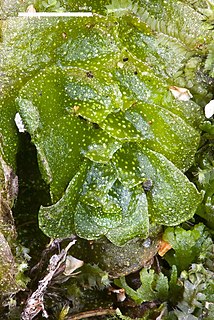
The Antarctic fur seal, is one of eight seals in the genus Arctocephalus, and one of nine fur seals in the subfamily Arctocephalinae. Despite what its name suggests, the Antarctic fur seal is mostly distributed in Subantarctic islands and its scientific name is thought to have come from the German vessel SMS Gazelle, which was the first to collect specimens of this species from Kerguelen Islands.

Sphaerocarpales is an order of plants within the liverworts. Approximately twenty species are in this order which is sub-divided into three families: Sphaerocarpaceae and Riellaceae, as well as the extinct family Naiaditaceae. The inclusion of the Naiaditaceae is uncertain, and the family has sometimes been assigned to the Haplomitriales.

The Phytomyxea are a class of parasites of plants. They are divided into the orders Plasmodiophorida and Phagomyxida. A more common name for them is the plasmodiophorids, but this does not always include Phagomyxa.

Utricularia warburgii is a species of terrestrial bladderwort found in China, where it grows in sunny wet meadows at an altitude of 900 m. It belongs to the section Nigrescentes and is closely related to U. caerulea.

William Justus Goebel was an American politician who served as the 34th Governor of Kentucky for four days in 1900 after having been mortally wounded by an assassin the day before he was sworn in. Goebel remains the only state governor in the United States to be assassinated while in office.

Haplomitriopsida is a newly recognized class of liverworts comprising fifteen species in three genera. Recent cladistic analyses of nuclear, mitochondrial, and plastid gene sequences place this monophyletic group as the basal sister group to all other liverworts. The group thus provides a unique insight into the early evolution of liverworts in particular and of land plants in general.

Treubia is a genus of liverworts in the family Treubiaceae. There are seven species, all of which are restricted to the southern hemisphere. Five of the species occur in Australasia and the other occurs in Chile. All species are dioicous, with separate male and female gametophytes.
Colura zoophaga is a species of epiphytic liverwort that is endemic to the African highlands, specifically parts of Kenya. It belongs to the genus Colura, which has been hypothesized to be carnivorous as early as 1893. It is a recently described species that was the subject of the first scientific study aimed at investigating the allegations of carnivory in liverworts.

The Jehol Biota includes all the living organisms – the ecosystem – of northeastern China between 133 and 120 million years ago. This is the Lower Cretaceous ecosystem which left fossils in the Yixian Formation and Jiufotang Formation. These deposits are composed of layers of tephra and sediment. It is also believed to have left fossils in the Sinuiju series of North Korea. The ecosystem in the Lower Cretaceous was dominated by wetlands and numerous lakes. Rainfall was seasonal, alternating between semiarid and mesic conditions. The climate was temperate. The Jehol ecosystem was interrupted periodically by ash eruptions from volcanoes to the west. The word "Jehol" is a historical transcription of the former Rehe Province.
Utricularia moniliformis is a small perennial carnivorous plant that belongs to the genus Utricularia. It is endemic to Sri Lanka. U. moniliformis grows as a lithophyte on wet rocks at altitudes from 750 m (2,461 ft) to 2,300 m (7,546 ft). It was formally described as a species by Peter Taylor in 1986, although it was first recorded as U. orbiculata by George Henry Kendrick Thwaites in 1860 and later by Karl Immanuel Eberhard Goebel in 1890.

Chlaenius is a large and diverse genus of ground beetle. It is native to the Palearctic realm, Afrotropical realm, and Nearctic realm. Worldwide, roughly 1,000 species are currently recognized with the majority of known species occurring in the Oriental and Afrotropical regions. The genus is divided into many subgenera.

Mastax is a genus of beetles in the family Carabidae, containing the following 52 species:
Agastus is a genus of beetles in the family Carabidae, containing the following species:
Anaulacus is a genus of beetles in the family Carabidae, containing the following species:
Dromoceryx is a genus of beetles in the family Carabidae, containing the following species:
Sfitakantha is a genus of beetles in the family Carabidae, containing the following species:
Eustra is a genus of beetles in the family Carabidae, containing the following species:
Holconotus is a genus of beetles in the family Carabidae. The scientific name of the genus is for the first time published in 1846 by Schmidt-Goebel. Contains the following species:

Neocollyris cruentata is a species of ground beetle in the genus Neocollyris in the family Carabidae. It was described by Schmidt-Goebel in 1846.
Daltoniaceae is a family of moss in the order Hookeriales.










